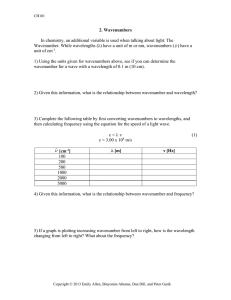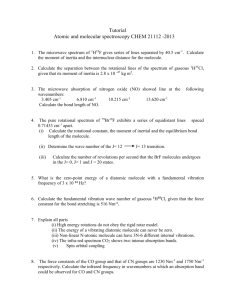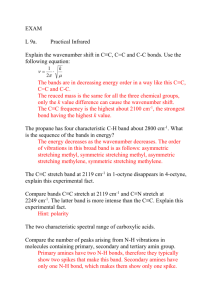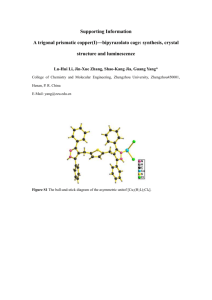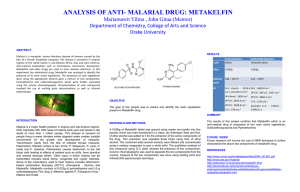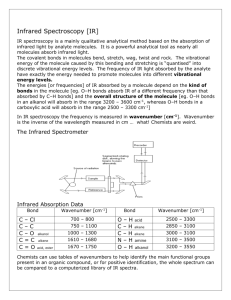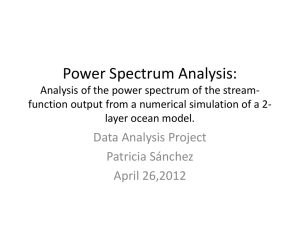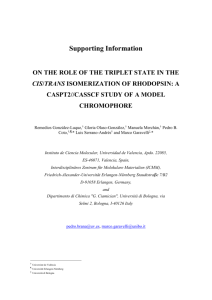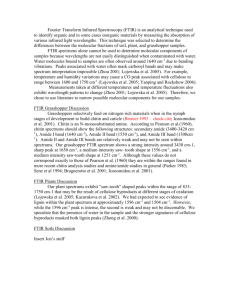ESI for 4halophenols paper_3_4_2013
advertisement
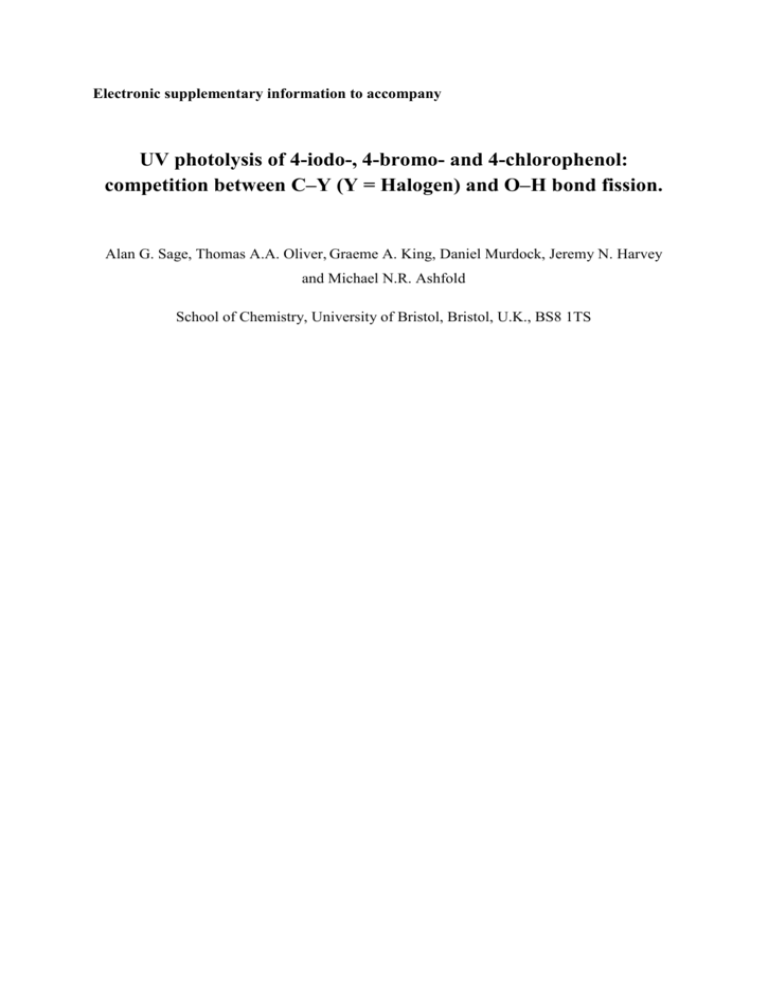
Electronic supplementary information to accompany UV photolysis of 4-iodo-, 4-bromo- and 4-chlorophenol: competition between C–Y (Y = Halogen) and O–H bond fission. Alan G. Sage, Thomas A.A. Oliver, Graeme A. King, Daniel Murdock, Jeremy N. Harvey and Michael N.R. Ashfold School of Chemistry, University of Bristol, Bristol, U.K., BS8 1TS Table S1 Calculated anharmonic wavenumbers (in cm-1) for the normal mode vibrations for the ground state 4-HOPh radical (Cs symmetry) calculated at the DFT/B3LYP/6-311+G** level, labelled in Herzberg notation.1 Mode Label Symmetry Mode Label Symmetry a' Wavenumber /cm-1 3838 ν16 a' Wavenumber /cm-1 1044 ν1 ν2 a' 3190 ν17 a' 991 ν3 a' 3176 ν18 a' 808 ν4 a' 3171 ν19 a' 615 ν5 a' 3146 ν20 a' 538 ν6 a' 1635 ν21 a' 405 ν7 a' 1593 ν22 a" 948 ν8 a' 1480 ν23 a" 911 ν9 a' 1435 ν24 a" 808 ν10 a' 1327 ν25 a" 782 ν11 a' 1308 ν26 a" 660 ν12 a' 1266 ν27 a" 479 ν13 a' 1185 ν28 a" 407 ν14 a' 1169 ν29 a" 293 ν15 a' 1100 ν30 a" 242 Table S2 Calculated anharmonic wavenumbers (in cm-1) for the normal mode vibrations for the ground state 4-IPhOH, 4-BrPhOH and 4-ClPhOH radicals calculated using DFT at the DFT/B3LYP level of theory, labelled according to Wilson notation.2 The 6311+G** basis set was used for calculating wavenumbers for the 4-BrPhO and 4-ClPhO radicals, but is unsuitable for calculations involving elements lying below period 3: thus the DGDZVP basis set was used when calculating the 4-IPhO radical wavenumbers. Mode Label Symmetry 20a Wavenumber / cm-1 4-IPhO 4-BrPhO 4-ClPhO a1 3223 3202 3205 13 a1 3207 3186 3189 8a a1 1577 1573 1579 19a a1 1500 1495 1495 7a a1 1416 1418 1419 9b a1 1171 1171 1170 18a a1 1047 1054 1079 1 a1 982 985 968 12 a1 808 804 805 6a a1 589 609 649 2 a1 246 291 379 20b b2 3222 3200 3205 7b b2 3208 3186 3190 8b b2 1501 1497 1495 19b b2 1434 1428 1419 14 b2 1283 1287 1287 3 b2 1278 1268 1268 15 b2 1112 1111 1110 6b b2 610 613 616 18b b2 448 453 455 9b b2 199 228 274 5 a2 971 980 978 10a a2 785 787 785 16a a2 377 379 381 17a b1 967 967 967 4 b1 851 851 852 10b b1 709 695 709 16b b1 493 491 501 17b b1 259 263 276 11 b1 89 96 107 Table S3 SOC state labels, dominant electronic configurations, vertical excitation energies calculated at the equilibrium RCI bond length, weights of the respective SOF states from which the SOC states are derived, and transition dipole moments/polarisations calculated for 4-IPhOH at the SOC-CASPT2(12/10)/cc-pVTZ level of theory. Z is aligned with the C–I bond axis and the ring lies in the YZ plane. State label Electronic Energy (C2v equivalent) transition / eV Component TDM / Spin-orbit free state Debye (axis) ππ * 2A'' ππ * 3.79 98.9% A' 2A' (1B2) ππ* 3.79 99.4% 3A' 4.03 3 3 0.000 3 3 1A'' 3A'' nσ* 3.79 3 0.001(X) 3 0.038(X) 99.3% A' 0.019(Y)+0.000(Z) 83.8% A'' + 15.2% A' 3A' (2A1) nσ* 4.03 83.6% A'' + 16.2% A' 0.001(Y)+0.064(Z) 4A' (2B2) nσ* 4.09 95.5% 3A'' + 3,9% 1A' 0.189(Y) ππ * 5A'' ππ * 4.25 71.7% A' + 28.2% A' 5A' (3B2) ππ* 4.25 99.8% 3A' 4A'' 4.25 4.38 3 3 0.464(X) 3 3 0.004(X) 71.6% A' + 28.1% A' 1 0.002(Y) 3 3 6A'' nσ* 7A'' ππ * 51.9% A'' + 40.0% A' + 7.2% A' 4.42 96.1% A' + 3.6% A' 0.008(X) 6A' (3A1) ππ* 4.42 99.8% 3A' 0.000 8A'' ππ* 4.43 88.7% 3A' + 5% 3A'+3% 1A'' 0.002(X) 3 3 0.047(X) 7A' (4B2) ππ * 4.53 99.9% A' 0.279(Y)+0.011(Z) 9A'' nσ* 4.76 83.5% 3A' + 15.4% 1A'' 0.000 8A' (4A1) nσ* 4.78 82.2% 3A' + 16.1% 3A'' 0.045(Z) 10A'' nσ* 4.87 1 3 1 53.8% A' + 44.8% A'' 1 3 0.354(X) 3 9A' (5B2) nσ* 5.43 92.6% A' + 3.9 % A'' + 4.5% A' 0.943(Y)+0.002(Z) 10A' (5A1) ππ* 5.69 96.0% 1A' + 3.9% 3A'' 0.047(Y)+3.923(Z) 11A' (6A1) nσ* 5.96 3 0.004(Y)+0.003(Z) 3 99.5% A' 11A'' nσ* 5.96 99.1 % A' 0.000 12A'' nσ* 5.96 99.1 % 3A' 0.008(X) Table S4 SOC state labels, dominant electronic configurations, vertical excitation energies calculated at the equilibrium RCCl bond length, weights of the respective SOF states from which the SOC states are derived, and transition dipole moments/polarisations calculated for 4-ClPhOH at the SOC-CASPT2(12/10)/cc-pVTZ level of theory. Z is aligned with the C–Cl bond axis and the ring lies in the YZ plane. State Label Electronic Energy Proportions of spin-orbit free Component TDM / transition Debye (axis) / eV states 2A' ππ * 3.81 3 100% A' 0.000 1A'' ππ* 3.81 99.6% 3A' 0.000 2A'' ππ * 3A'' ππ * 4.18 4A'' ππ* 3A' ππ* 4A' ππ * 4.43 100% A' 0.000 5A'' ππ* 4.43 100% 3A' 0.000 6A'' ππ* 4.43 100% 3A' 0.000 5A' ππ * ππ * 6A' 3 0.000 3 100% A' 0.000 4.18 100% 3A' 0.000 4.18 100% 3A' 0.000 3.81 4.51 5.92 99.6% A' 3 1 0.565(Y)+0.005(Z) 1 0.293(Y)+1.924(Z) 100% A' 100% A' Figure S1 Spin-orbit resolved PECs for 4-IPhOH as a function of RC–I, calculated at the SOCCASPT2(12/10)/cc-pVTZ level with all other degrees of freedom clamped at the MP2 ground state equilibrium values. The adiabatic outputs have been approximately diabatized by inspecting the energies and wavefunction coefficients. Figure S2 Spin-orbit resolved PECs for 4-ClPhOH as a function of RC–Cl, calculated at the SOCCASPT2(12/10)/cc-pVTZ level with all other degrees of freedom clamped at the MP2 ground state equilibrium values. The adiabatic outputs have been approximately diabatized by inspecting the energies and wavefunction coefficients. 1 G. Herzberg, Infrared and Raman Spectra of Polyatomic Molecules, Van Nostrand, (1945). 2 E.B. Wilson, Phys. Rev. 45, 706 (1934).
